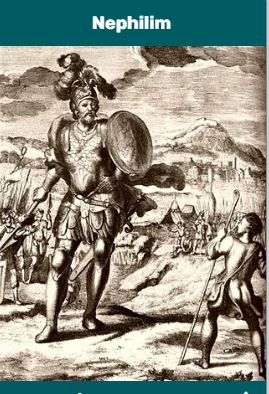The Nephilim and the Giants of the Bible
The story of the Nephilim in the Bible is very difficult to understand. Several issues are involved in the story of the Nephilim: their relationship with the sons of God, their relationship with the giants mentioned in the Bible, and whether the Nephilim survived the flood in Noah’s days: “The Nephilim were on the earth in those days – and also afterward” (Genesis 6:4). A recent book of the Nephilim identifies them with the demigods of Sumerian mythology. The purpose of this article is to study the Nephilim and their relationship with the Anakim, the giants mentioned in the Bible.
After the people of Israel left Egypt, they came to the borders of Canaan, the land that Yahweh their God had promised to them. Before they entered the land they asked Moses to send twelve spies to investigate the land and its people (Numbers 13:1–33). With the exception of Joshua and Caleb, the spies brought back a very pessimistic report of their survey of Canaan. To them, the fortified walls of the Canaanite cities were an overwhelming obstacle for their conquest of the land (Numbers 13:28). The spies were also terrified by the size of the inhabitants of Canaan. They said: “The land we explored devours those living in it. All the people we saw there are of great size. We saw the Nephilim there (the descendants of Anak come from the Nephilim). We seemed like grasshoppers in our own eyes, and we looked the same to them” (Numbers 13:32–33).
In their exaggeration of the situation, the spies spoke to the assembly of the leaders of Israel of the terrible predicament waiting the people of Israel. The spies added that, in addition to being people of gigantic stature, the Anakim were the Nephilim, the dreadful people who lived on earth in the days of Noah, the days before the flood.
Twice the Kings James Version uses the word “giant” to translate the word Nephilim in Numbers 13:33. In this text, the word Nephilim is used to describe the inhabitants of Canaan. In addition, the King James Version uses the word “giants” several other times, but most of them are either a translation for the Hebrew word gibbôr, “warrior” (Job 16:14 NIV) or for the Hebrew word rephā’îm, “Rephaim” (Deuteronomy 2:11, 20). The KJV also translates the Hebrew word rāphāh, “Rapha”, as “giants” (2 Samuel 21:22). The Rephaim (The word Rephaim is a plural word in Hebrew. The NIV uses Rephaites to express the plural sense in English) were another group of people who inhabited the land of Canaan before the time of the Exodus (Genesis 15:20).
The identification of the Anakim and the Nephilim in the Old Testament is a vexed problem. The reason is that the passages where these two names appear are not easy to interpret. Since the contexts in which these passages appear are not clear, scholars have offered different interpretations in their attempt to identify the Anakim and the Nephilim.
According to the book of Joshua, the Anakim are associated with the southern part of Canaan, specially the city of Hebron. The original name of Hebron was Kiriath Arba, a name given after its original founder, Arba, the forefather of Anak (Joshua 15:13) and the greatest of the Anakim (Joshua 14:15). Thus, according to this brief genealogical information, the Anakim were the sons of Anak (Numbers 13:22). They were a tall people who lived in the land of Canaan (Deuteronomy 2:21).
The word anak in Hebrew means “long-neck.” The Anakim were not the only group of tall people who lived in the land of Canaan. The Rephaim, who lived in the territory of the Ammonites, a people whom the Ammonites called Zamzummites, were as tall as the Anakim (Deuteronomy 2:20–21). The Emmim, who lived in the territory of the Moabites also were as tall as the Anakim (Deuteronomy 2:10). Both the Emmim and the Anakim were considered to be Rephaim (Deuteronomy 2:11). This identification of the Rephaim with the Anakim and of the Emmim and the Anakim with the Rephaim reflects the popular view that all the inhabitants of the land of Canaan were giants.
Because the word Anak appears in the Hebrew Bible with a definite article, and because Arba, the father of Anak is already called the greatest of the Anakim (Joshua 14:15), it is possible that Anakim is a collective word used to describe, not a nation or a tribe, but rather people who had one thing in common: they were all of gigantic stature.
The words of the spies, however, introduce another problem. The problem develops because the spies identified the offspring of the Anakim with the Nephilim of Genesis 6:4. The identification of the Nephilim is made difficult because the most important passage where the word appears (Genesis 6:1–4) is obscure and has produced numerous, and at times, contradictory interpretations.
Questions about the identification of the Nephilim abound. Even the English translations of the Old Testament do not agree on how to translate the word. For example, the KJV translates the word as “giants.” This translation was influenced by the Septuagint, the Greek translation of the Old Testament, began by the Jewish community living in Egypt around 175 B.C. The Septuagint used the word gigantes to translate the Hebrew word nāphal. Most modern translations (NIV, NASB, RSV, NEB), leave the word Nephilim untranslated, thus putting the burden of interpretation upon the reader.
Most scholars today derive the word Nephilim from the Hebrew verb nāphal, which means “fallen ones.” Thus some scholars view the Nephilim as the ones fallen from heaven, that is, divine beings or angels. Others have identified the Nephilim with robbers and people who preyed upon individuals, violent men who fell upon their victims. Some scholars have derived the Nephilim from a Hebrew word nephel, which means “miscarriage”. These scholars understand the Nephilim as unnaturally begotten superhuman beings emerging from miscarriages.
A more difficult problem is posed by the relationship between the Nephilim of Genesis 6:4 and the “sons of God” and “the daughter of men” of Genesis 6:2. Genesis 6:1–4 does not clearly say whether the Nephilim were the offspring of the marriage between the sons of God and the daughters of men. Since scholars are divided on this issue, it becomes imperative to look at the identification of the Nephilim from both perspectives.
Presupposing that the Nephilim are the progeny of the sons of God and the daughters of men, the question becomes: who were their parents? Several views have gained popularity among interpreters of Genesis 6:1–4.
First, many interpreters identify the sons of God with the believing descendants of Seth and the daughters of men with the unbelieving descendants of Cain. Under this interpretation, the Nephilim would then be men who were born of these unequally yoked marriages into ungodly homes; men who lived a life of violence and who fell upon innocent victims.
A second view identifies the sons of God with ancient dynastic rulers who practiced polygamous marriages and the daughters of men were the women in their harem. Their children, the Nephilim, then were mighty tyrants whose life of oppression and tyranny was intolerable to God.
A third view identifies the sons of God with fallen angels and the daughters of men with human women. According to this view, the Nephilim were men born out of an unnatural relationship, half human, half demonic, a violation of the created order. This is the view taken by the Good News Bible, which translates Genesis 6:4 as follows: “In those days, and even later, there were giants on the earth who were the descendants of human women and supernatural beings. They were the great heroes and famous men of long ago.”
Those who presuppose that the Nephilim were not the children of the sons of God and the daughters of men distinguish them from the gibborim, “the heroes that were of old, warriors of renown” (Genesis 6:4 NRSV). That is the position taken by Keil (Keil 1951:137) who suggests that the Nephilim were tyrants and oppressors who were already in existence before the sons of God cohabited with the daughters of men. Hamilton also takes a similar position, by saying that the Nephilim were men of imposing stature and that the mighty men, the gibborim, were the children born of the union between the sons of God and the daughters of men.
Hamilton translates 6:4 by setting the first part of the verse in parenthesis, as an explanatory sentence: “(The Nephilim were on the earth in those days–and later too.) Whenever the sons of God had intercourse with the daughters of humankind, they fathered children by them. These were the mighty men of old, men of reputation” (Hamilton 1990:261).
A fourth view, which has not gained popularity among scholars, says that the Nephilim were the sons of God, and they were the ones committing the sins that brought about the moral decline in the days of Noah and served as the reason for the deluge (Birney 1970:51).
Several people of gigantic stature appear in the Old Testament: Goliath, the warrior of the Philistines, was six cubit and one span in height (1 Sam 17:4 KJV), that is, “over nine feet tall” (NIV). Og, king of Bashan and one of the Rephaim, had a bed of iron that was 13 cubits long and 4 cubits wide (Deuteronomy 3:11 KJV) or “more than thirteen feet long and six feet wide” (NIV). Benaiah, one of David’s warriors, killed an Egyptian soldier who was 5 cubits tall (1 Chronicles 11:23 KJV) or “seven and half feet” (NIV).
Since the average size of an Israelite at the time of the conquest was slightly above five feet (Callaway 1983:44) , any person over six feet was considered to be a giant. Many of the Philistine soldiers that David and his soldiers killed were “descendants of Raphah” (2 Samuel 21:18 NIV) or “the descendants of the giants” (2 Samuel 21:18 NRSV), although only one of them was considered to be a huge man: “a man of great size, who had six fingers on each hand, and six toes on each foot, twenty-four in number; he too was descended from the giants” (2 Samuel 21:20 NRSV). After the time of David, the Rephaim are not mentioned again in the Old Testament.
Although the spies were utterly afraid of the Anakim (the “giants”), the Anakim were conquered by Joshua and driven from the land. Only a small remnant survived; they found refuge in the Philistine cities of Gaza, Gath, and Ashdod (Joshua 11:21–22). Caleb conquered Hebron, the stronghold of the Anakim and drove out the three clans of the Anakim (Joshsua 15:14).
Thus, it is possible to conclude that when the Israelite spies said that they saw the Nephilim in the land, they were using the word as a synonym for Anakim. The Nephilim did not survive the flood. Both words, Anakim and Nephilim, are used to describe the imposing physical condition of the original inhabitants of the promised land. Centuries later, the prophet Amos, referring to the overwhelming size of the original inhabitants of Canaan, said that the Canaanites were as “tall as the cedars and strong as the oaks” (Amos 2:9).
NOTE: For a comprehensive collection of studies on the Book of Genesis, read my post Studies on the Book of Genesis.
BIBLIOGRAPHY
Birney, Leroy. “An Exegetical Study of Genesis 6:1-4.” Journal of the Evangelical Theological Society 13 (1970): 43–52.
Callaway, Joseph. “A Visit with Ahilud: A Revealing Look at Village Llife When Israel First Settled the Promised Land.” Biblical Archaeology Review 9 no 5 (September/October 1983): 42–53.
Hamilton, Victor P. The Book of Genesis – Chapters 1-17. New International Commentary on the Old Testament. Grand Rapids: Eerdmans, 1990.
Keil, C. F. and F. Delitzsch. Biblical Commentary on the Old Testament. Vol. 1: The Pentateuch. Grand Rapids: Eerdmans, 1951.
Claude Mariottini
Emeritus Professor of Old Testament
Northern Baptist Seminary
NOTE: Did you like this post? Do you think other people would like to read this post? Be sure to share this post on Facebook and share a link on Twitter or Tumblr so that others may enjoy reading it too!
I would love to hear from you! Let me know what you thought of this post by leaving a comment below. Be sure to like my page on Facebook, follow me on Twitter, follow me on Tumblr, Facebook, and subscribe to my blog to receive each post by email.
If you are looking for other series of studies on the Old Testament, visit the Archive section and you will find many studies that deal with a variety of topics.






